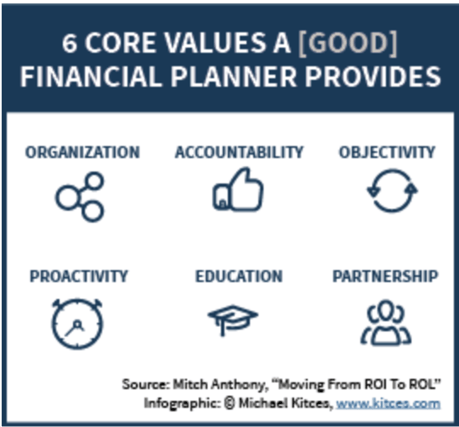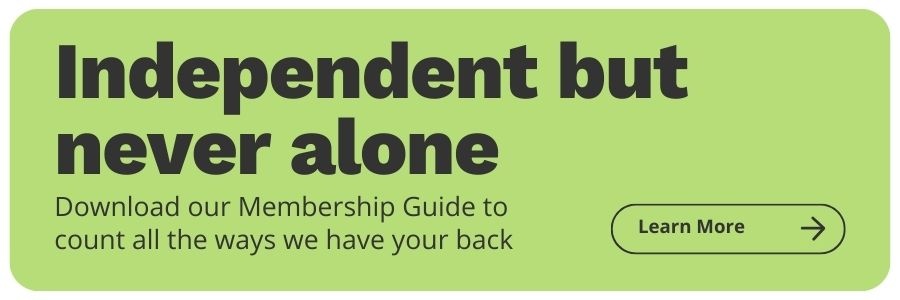Craft a Compelling Value Proposition in 6 Steps (Template Included)
Share this
The development of a value proposition is a vital part of a firm’s business strategy. A savvy proposition provides an advisory firm with a method to influence the decision-making of potential clients, and though often shared in networking conversations, it is a smart inclusion in a firm’s website and marketing collateral.
Why a Value Proposition?
Your direct, succinct, and easy to understand value proposition statement should serve to clarify to your prospect what you do as an advisor and how your product or service is different from your competitors. Most importantly, it should allude to how you work to serve your clients’ needs, outlining how your passion and expertise can work to uniquely serve your client, getting them past challenges and toward desired goals.
However, a value proposition is only the beginning of engaging your ideal audience. If your value proposition catches the attention of a prospect, your next task is to further outline how what you have to offer can more specifically meet the needs, goals, and challenges they face. Best done through a strategic conversation flow (and yes, meaning you are not doing all the talking, but rather engaging with your prospect to learn about them), you’ll work to drill down to what truly matters to your prospect while outlining how your expertise fits their needs.
A few questions can help you clarify how to hone your high-level sharing of what you do and how it will impact your target audience, i.e., your financial advisor value proposition statement.
- Who is your audience? You need to be crystal clear who your target client is, who you best serve.
- What is important to this demographic? What keeps them up at night, what goals do they aspire to achieve?
- What makes you qualified (and/or passionate) about serving this demographic? More specifically, your “why.”
- What results have you helped others achieve? Sharing stories of the wins your expertise has helped your clients achieve.
Those four questions will help you carve out an authentic, meaningful overview of who you serve, what you do, and how you’ve helped others, enough to get the conversation going if your prospect wants to learn more. Also key is that your value proposition statement work in sync with the values you ascribe to within your company, which I recommend you list on your website.
The Value of Defining Your Firm Values
Mitch Anthony, a respected thought leader in the advisor community, particularly around navigating discovery conversations with clients, is best known for having created “Financial Life Planning” (2001), “Return on Life” (2005), and most recently, “Life-Centered Planning” (2017). His other books include StorySelling for Financial Advisors, The New Retirementality, and Your Clients for Life. Mitch does a great job of outlining what he calls not a “return on investment,” but rather what he coins, “return on life,” through the values he recommends that a good financial planner provide and listed within this Kitces.com article, 6 Key Value Propositions A Good Financial Planner Can Provide For Clients Seeking A Better “Return On Life”

Mitch goes on to describe in more detail each value point:
Organization: We will help bring order to your financial life by assisting you in getting your financial house in order (at both the “macro” level of investments, insurance, estate, taxes, etc., and also the “micro” level of household cash flow).
Accountability: We will help you follow through on financial commitments by working with you to prioritize your goals, show you the steps you need to take, and regularly review your progress towards achieving them.
Objectivity: We bring insight from the outside to help you avoid emotionally driven decisions in important money matters by being available to consult with you at key moments of decision-making, doing the research necessary to ensure you have all the information, and managing and disclosing any of our own potential conflicts of interest.
Proactivity: We work with you to anticipate your life transitions and to be financially prepared for them by regularly assessing any potential life transitions that might be coming and creating the action plan necessary to address and manage them ahead of time.
Education: We will explore what specific knowledge will be needed to succeed in your situation by first thoroughly understanding your situation, then providing the necessary resources to facilitate your decisions, and explaining the options and risks associated with each choice.
Partnership: We attempt to help you achieve the best life possible but will work in concert with you, not just for you, to make this possible by taking the time to clearly understand your background, philosophy, needs, and objectives, work collaboratively with you and on your behalf (with your permission), and offer transparency around our own costs and compensation.
Mitch shares in his interview with Michael Kitces,
“In fact, it’s not hard to imagine an advisor’s website literally just using these six terms, and the associated explanations, as their exact explanation of ‘What We Do For You, The Client!’ While still abstract terms, ‘we provide Organization, Accountability, Objectivity, Proactivity, Education, and Partnership’ is still much clearer and more specific than ‘we provide a customized, individualized personal financial plan!’”
We’ve all heard the overused, amorphous terms such as comprehensive plan, fiduciary promise, peace of mind, or a holistic approach. In surveying consumers at the #XYPNLIVE 2020 Consumer Focus Panel that I co-hosted, we found that most consumers are lost with this commonly shared advisor verbiage (industry jargon). They are often embarrassed to ask the meaning of these terms yet crave specificity and clarity around what exactly an advisor can do for them!
Converting Your Firm Values into a Brief and Authentic Value Statement
Regarding the value statements Mitch lists above, we will go further by taking the key points of each value point and using those to craft your more specific value proposition. Here are the key points of each value statement:
Organization: We will help bring order to your financial life
Accountability: We will help you follow through on financial commitments
Objectivity. We bring insight from the outside to help you avoid emotionally driven decisions in important money matters
Proactivity: We work with you to anticipate your life transitions and to be financially prepared for them
Education: We will explore what specific knowledge will be needed to succeed in your situation
Partnership: We attempt to help you achieve the best life possible but will work in concert with you, not just for you, to make this possible
My recommended next step is weaving these core statements into a succinct and cohesive financial advisor value proposition.
“We help bring order to your financial life by bringing insight from the outside to help you avoid emotionally driven decisions in important money matters. We work with you to anticipate your life transitions and be financially prepared for them and help you follow through on financial commitments. We will explore what specific knowledge will be needed to succeed in your situation so we can help you achieve your best life possible!”
Notice in this example where the “we” is stated, the use of “you” and “together.” As an advisor, it’s your job to gauge whether using “you” statements might come off too strongly to the person you’re addressing, creating unnecessary pressure, which might come off as pushy.
Conversely, you could create an example of how you might work with a fictitious client, which avoids pressure and can create a more positive air of “I want the result he’s alluding to” interest through your third-party reference. Of key importance, consider where the value statements from above are transcribed into a personable, authentic statement of what your firm can do for the person seeking guidance or who’s just interested in learning about your firm.
Consider What People Want from a Financial Advisor
Another Financial Advisor Success podcast episode, Creating Tangible Advisor Marketing Messages For Intangible Financial Planning Services With Gail Graham, addresses some additional insights into framing a value proposition statement. Gail founded the marketing firm Graham Strategy, working with both financial advisory and B2B vendors serving advisors. She worked with her clients to design effective marketing messages to better reach their desired clientele. Over the years, she’s gained worthy insights into how to effectively market an intangible service like financial planning. In recounting her research around what people want from a financial advisor and what she learned, she shares with Michael:
“So what did people want? They wanted things to be easier, more understandable. They wanted managing their affairs to take less time. They wanted to feel like the people that worked with them really understood them, not in their silos but understood them as human beings across those needs.”
In interviewing and working with a variety of advisors from XY Planning Network in my position as Sales Coach, I was surprised to find a wide range of ideas around what a financial advisor value proposition was. From long and winding descriptions of service—with no shortage of industry jargon—to one statement, short and sweet, and frankly, rather compelling,
“I help professionals over age 50 retire and not get killed in taxes."
In seeing a disparity in clear, descriptive, meaningful, and differentiating value propositions, I created a structure to hone down to the essentials of what a prospect might need to consider to have a further conversation with an advisor. Though I share a six-step template below, let’s first look at steps 1-4, which once identified, will help you craft your statement. Steps five and six will guide you in further conversations with your prospect as you learn what is important to them to effectively customize your responses.
6 Steps for Creating Your Value Proposition and Additional Prospect Talking Points
Template and Example for Developing Your Value Proposition
Advisor Niche: Young Teachers and Their Families
- Your who—you work with what audience: I work with young teachers and their families who are looking for support with their finances.
- Your why—your passion and experience with that group: I come from a family of teachers and was one myself and passionately understand some of the challenges they face and the goals they have.
- Their challenges and goals: I help my teacher clients to identify their life priorities. I know how it feels moving past student loan debt or the anxiety of dealing with tax challenges or hoping you are choosing the best benefits options, helping them plan for the future. I work with my clients to sort through these issues so they feel in control of the options available to them in their lives.
- Your expertise: I do this through using my skillset as an advisor, helping them organize their finances, educating them on growth options they have, and acting as a proactive, accountability partner through life’s many ups and downs.
(You might add your specific strategies here, tax planning, employee benefits optimization, cash flow, and debt management, financial goal planning, college planning, etc.)
Again, to craft your value statement, work to combine the first four steps of the template into a succinct statement of your overall key value to a client, allowing the other stated points to flow in a subsequent conversation with your prospect.
A value proposition crafted from the four listed statements above:
"Having been a teacher, I have a passion for working with educators. As a financial guide, coach and mentor, I understand their core issues and apply my unique expertise to guide educators toward the life they most want to live."
Consider from here how you might expound on the brief statement that shares an overview of what you do. If what you do resonates with your prospect, they might ask ‘how’ do you help this demographic or for that matter get to what’s important to them? Points #5 and #6 in the template continued below will help guide you to these important talking points.
- Results you get and work toward: We work together to name key goals and roadblocks to get there. My goal is to help them create the life they most desire to live, understanding and improving on behaviors that work in the clients’ best interest and through sharing financial strategies I recommend.
- Sharing a story of someone you helped: One couple I worked with was having some real challenges in purchasing their first home. They were stressed over the debt and the money they felt they were wasting through renting. We worked together to create a budgeting plan and to leverage some tax benefits they were unaware of. I helped them also to maximize the sale of a piece of land they were inheriting, helping them into a new home within a year of working together.
After working on the above template with the advisor who shared his clippy, short statement mentioned above, we came up with a version that shares more specifics around what he does for his clients, yet still with brevity and punch:
Before:
“I help professionals over age 50 retire and not get killed in taxes."
After:
“I work as a financial consultant to business owners and real estate investors. As a business owner myself I know the issues they face, one being a desire to save on tax implications in their businesses. I help my clients avoid huge capital tax bills, freeing them up to live the life they most desire.”
Similarly, below is a before and after value proposition and template example I worked on with seasoned advisor, Jennifer Owen with Juno Capital Strategy, LLC.
Before:
“Juno Capital Strategy, LLC is a bespoke financial advisory firm created to help women identify their resources, amplify their assets and power the life they seek to lead. We are here to provide thoughtful financial strategy, and dynamic guidance to harness your resources in service of your evolving life. We are passionate about engaging a variety of assets to give life to your dreams and goals. And every goal, no matter the size, starts with a plan. I am a financial strategist committed to helping you thrive, and I created my firm to help you plan, to help you protect & to help you prosper!“
In an attempt to create a more succinct and streamlined statement around her passion, offering, and how she helps other advisors, below is her templated worksheet to get to the core of what she does and below that, our reworked value proposition.
Financial Advisor Value Proposition Template
- Your who—you work with what audience: I work with women in their mid-forties to mid-sixties who are going through major life changes such as divorce, career changers, empty nesters, and recent widows.
- Your why—your passion and experience with that group: As a woman in my late forties, I have a passion for and understand the issues this demographic faces.
- Their challenges and goals: I work with these women to identify the financial resources they have and help organize those resources to better serve their needs while looking for opportunities I uncover.
- Your expertise: I do this by taking my knowledge and experience to create a personalized roadmap to build confidence in successfully taking control of their life in ways they love.
- Results you get and work toward: I connect my clients to the resources that help them get where they want to go. Acting as their advocate, coach, and guide, I work to build their knowledge and confidence in their path forward. The result is an overall security in knowing I have their back to assure we’re doing all the right things to help them grow forward.
- Sharing a story of someone you helped: I worked with a woman who had newly inherited a sizable sum of money. She was unsure and anxious on how to best invest her assets. After several sessions I learned more about her key life goals and other challenges and fears she was facing. Together we prioritized her life goals both practical and heartfelt. She left my office feeling heard, supported and confident in the path that together we crafted and which we will visit together a few times a year.
After:
“I have a passion for working with women experiencing major life changes helping them to realize and manage their financial resources more effectively. I do this by taking my knowledge and experience to create a personalized roadmap to build confidence in successfully taking control of their lives in ways they love.”
Summarizing your primary audience, your passion, expertise, and how you help your clients get to where they want to go is key, while not losing them with unnecessary verbiage and jargon!
Gail Graham goes on to say,
“Well, I think it's number one, really sharpening your message….really sharpening your message and knowing what you're going to say and that you have, you know, a value proposition that makes sense. A simple, clear, competitive one-pager that you make sure it's the same thing you're saying on your website, that you make sure your entire office can say, you know, stand up and deliver. Make sure that what you say is differentiated and powerful for the right target audience. And I believe say it in English. You know, I have found people pay attention when you talk like a human. I think that really matters."
And to her point, to share an effective value proposition you need to rehearse it aloud, rehearse it alone and importantly rehearse it in front of others. Ask for feedback on what they heard and can they share back, from your statement, what you do? An actor would never go on stage with lines he or she has learned without first rehearsing out loud. This is the most expedient way to learn if you are successfully communicating your desired intent, allowing your words to flow and the meaning to come across while in the presence of others, authentically and with heart.
Roleplaying might not be the favored practice of most numbers-driven financial advisors, yet I find it a core skill in the training I do with our members and a revelatory exercise for advisors once they’ve embraced the initial discomfort. I’ve found over the years as a former entrepreneur, that all the many aspects of running a business demand that we remain curious, flexible, introspective, and vulnerable as we learn new skills that are not in our core strengths. It’s those very new skillsets that shore up the areas within our firms that often make the greatest difference to running an integrated, successful business with its various parts flowing smoothly together!
In short, having a clear, concise, and authentic value proposition is a vitally important and worthy aspect of sharing what you do so you can communicate and serve the many and growing numbers of people who are waking up to the absolute need for fee-only advising help in their lives. With sincere respect and admiration for all you do!
.png?width=200&height=200&name=500x500%20(1).png) About the Author BB Webb
About the Author BB Webb
XYPN's Sales Coach BB Webb boasts an impressive background in the arts and as an entrepreneur. She first dipped her toe in the world of sales while touring her one-woman play across the country, and then dove in headfirst as the founder of an award-winning Atlanta-based special event venue. In 2014 BB published her book, Build Your Business: BB Webb’s Notes From the Highwire and has worked as an Executive Coach with small business owners.
BB’s goal is to help XYPN members build great relationships, plans, and processes for sharing their services as advisors. With a focus on consultative selling, her programs are designed to guide advisors in having meaningful conversations with prospects and sharing their value fearlessly and with joy.
Share this
- Road to Launch with XYPN Member Alan Skillern, CFP®, MBA
- Coaching for Better Time Management: Prioritizing Organic Growth in Your Daily Routine
- Boost Your Financial Advisory Practice: SEO Strategies and CRM Optimization for Sales Success
- Navigating the AI Revolution: What Financial Advisors Need to Know
- Advisor Blog (692)
- Financial Advisors (221)
- Growing an RIA (99)
- Digital Marketing (87)
- Marketing (84)
- Community (81)
- Start an RIA (76)
- Coaching (72)
- Business Development (71)
- Running an RIA (70)
- Compliance (69)
- Client Acquisition (65)
- Technology (64)
- XYPN LIVE (59)
- Entrepreneurship (56)
- Sales (49)
- Practice Management (44)
- Client Engagement (41)
- XYPN Books (38)
- Bookkeeping (37)
- Investment Management (37)
- Fee-only advisor (36)
- Lifestyle, Family, & Personal Finance (31)
- Employee Engagement (30)
- Client Services (25)
- Financial Education & Resources (24)
- Journey Makers (21)
- Market Trends (21)
- Process (14)
- Niche (11)
- SEO (9)
- Scaling an RIA (9)
- Career Change (8)
- Transitioning Your Business (7)
- Partnership (6)
- Transitioning To Fee-Only (4)
- Social Media (3)
- Transitioning Clients (3)
- Emerald (2)
- Persona (2)
- RIA (2)
- Onboarding (1)
- Sapphire (1)
Subscribe by email
You May Also Like
These Related Stories

Create Connection and Close the Sale with These 3 Sales Process Truths
Aug 9, 2021
15 min read

8 Tips to Skyrocket Your Sales Through the Power of Video
Dec 27, 2021
10 min read





